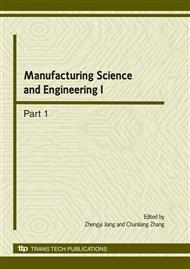p.386
p.390
p.395
p.400
p.404
p.408
p.412
p.416
p.420
Numerical Simulation and Evaluation of Local Thickness Increment in Ironing by Finite Element Method
Abstract:
Local increases in product sheet thickness effectively contribute to reducing total product weight. Products could be designed efficiently if a designer could predict and control the thickness distribution of formed products. This paper presents a numerical simulation and evaluation of the local thickness increment of products formed during the ironing process. To clarify the mechanism of the local increase of sheet thickness, a 3-D numerical simulation during ironing was performed by the Finite-Element Method. Tool shapes (contact angles with the original materials and contact length of the punch with the material) that primarily affect thickness changes of original materials were evaluated. It was found that the sheet thickness distribution could be controlled if the original material were relatively thick, when appropriate manufacturing conditions could be selected.
Info:
Periodical:
Pages:
404-407
Citation:
Online since:
March 2010
Authors:
Price:
Сopyright:
© 2010 Trans Tech Publications Ltd. All Rights Reserved
Share:
Citation:


